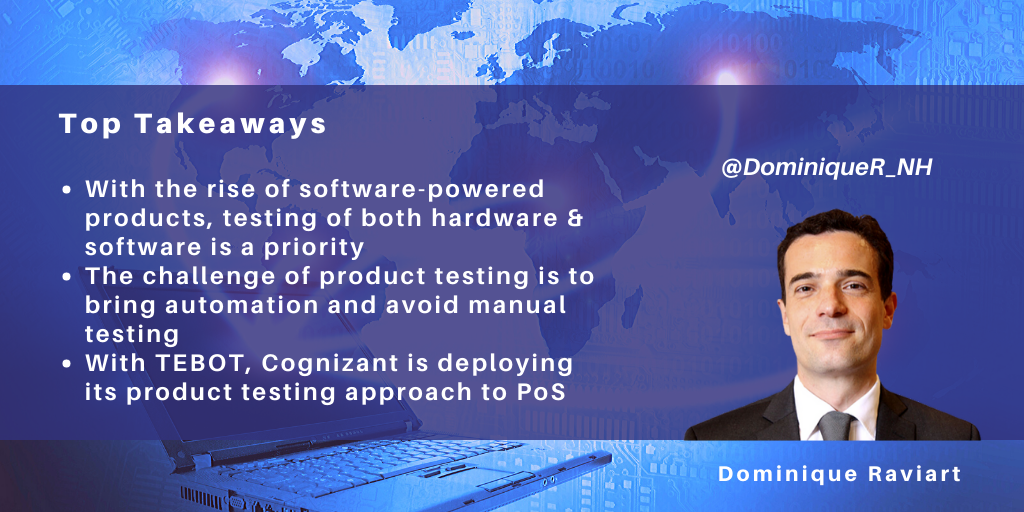Search posts by keywords:
Filter posts by author:
Related NEAT Reports
Other blog posts
posted on Feb 17, 2020 by Dominique Raviart
In a recent blog, we highlighted how Cognizant approaches the testing of connected devices. Testing connected devices brings new challenges to QA at two levels: conducting hardware testing and automation. Cognizant’s TEBOT IP is based on a combination of traditional test automation (mostly based on Selenium test scripts) and hardware powered by a Raspberry Pi, triggering physical actions/movements.
The PoS Ecosystem is Becoming More Diverse
Cognizant has identified a new use case for TEBOT, targeting point of sale terminals (PoS). The nature of PoS has changed over the years, with the rise of self-checkout terminals and a greater diversity of hardware, particularly in peripherals (e.g. barcode scanners) and a growing number of authentication methods (e.g. e-signature, PIN code) and payment methods (NFC, insert, or swipe).
The proliferation of hardware peripherals is challenging QA teams, with few vendors providing simulation software for their peripherals, and with a rising number of PoS/peripheral combinations.
These developments make PoS testing a good candidate for test automation.
In looking to automate human activities through TEBOT, Cognizant has focused on customer touch points; for example insert or swipe a card, enter PIN code or sign electronically. It has developed test scripts based on Selenium and conducted tests in its labs in Chennai.
Cognizant has conducted PoS testing for several clients, including:
- For a Canadian retailer, Cognizant ruled out conducting test automation using simulation software because of latency issues due to integration with third-party systems. The company used TEBOT, taking a payment transaction-based approach for PoS terminals, and identified 2,200 defects in its labs
- With a large Australian supermarket chain, where testing was previously performed manually, the challenge was the need to conduct PoS testing for both its owned stores and those of franchisees. In total, the client faced combinations based on 40 PoS types and 350 peripherals. In addition to deploying TEBOT, Cognizant deployed AI to analyze defect logs in the 25 sprints of the past year and predict where defects were likely in upcoming releases.
The PoS Industry Continues its UX Transformation
Cognizant believes that the PoS industry will continue to invest in new equipment and peripherals: AR/VR and mobile PoS will become more prominent and drive further focus on UX. The number of installed PoS is expected to increase by 10% each year and this will require further investment in test automation.
Combining Robot-based Test Automation & Crowdtesting
We continue to explore how to best automate connected devices in various forms. The market is large and also quickly expanding from its IoT products niche to all devices and equipment that combine hardware and embedded software/firmware and are connected. In short, the testing market potential is huge and goes across industrial and consumer devices and equipment. Cognizant’s approach with TEBOT focuses on functional testing. Looking ahead, we think that Cognizant approach should be combined with crowdtesting and UX testing. The company has a crowdtesting value proposition with its fastest offering, which can also provide UX testing, complementing the functional test capabilities that TEBOT brings.

